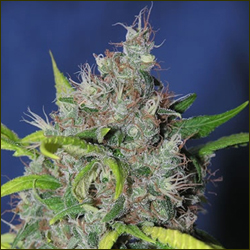
Aurora Borealis
Indica 50 / Sativa 50
Origins: Northern Lights #10 x Skunk #1
Flowering: 56-63 days
Harvest: late October
Aurora Borealis is the Latin name for the natural phenomena at the North Pole otherwise known as “Northern Lights”, which in turn is the name of one of this plant’s celebrity parents. Northern Lights is an indica strain that, during the 1980s, made its way from the Pacific Northwest to the Netherlands, where it has become a building block for many strains around the world. The Northern Lights #10 mother was selected for commercial production back in 1997. While Northern Lights was specifically bred for the then-fledgling indoor grow scene, the other parent in this famous pair, Skunk #1, was initially bred for outdoors and greenhouse cultivation. The resulting plants are of a medium height, with dark green foliage and short internodes and a 50/50 sativa/indica phenotype expression. Aurora Borealis may have a less recognizable name than her parents, but her genetics shine through to reveal her family ties.
This strain can be grown in all suitable mediums and will survive in most temperate regions. Outdoors, in Holland, the Aurora B. matures in mid-October. She comes up stocky with dark green foliage. Plants started in May in Holland, and left unpruned, usually finish at a height of around 5-6 feet. They yield around 500 grams per plant.
Indoors, the Aurora B. performs best under a sea-of-green regime at a density of 16-25 plants per square meter. She thrives on generous nutrient levels and performs best in a good, rich well aerated soil high in organic matter. Allow for a vegetative time of around 10 days or until the canopy cover is about 70% when viewed from above. Do not prune that canopy unless a longer vegetation time is required. All feeding should cease during the last 10 days of flowering so as not to impair the taste of the final product. The height of Aurora Borealis under this regime is usually around 1-2 feet and its yield ranges from 25 to 40 grams per plant, at 600 watts of light per square meter.
Once the plants mature they exhibit fairly long, broad colas with a medium density and very high resin content. The smell and taste is satisfyingly sweet, with a warm skunky undertone. The plant’s odor is very pungent until fully dried and cured. Aurora B.’s high leans toward the physical, starting strong, with a long lasting and well-balanced plateau and a gentle finish. For medical marijuana users, this strain works well to alleviate symptoms from which indicas are generally prescribed, such as chronic pain, spasms, sleeplessness and nausea.

